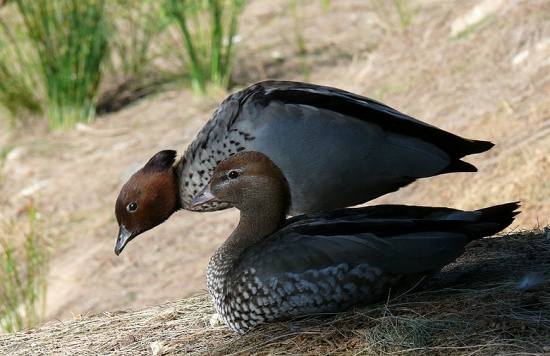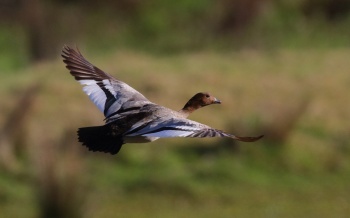(Attempt to disguise some copied text. Flight picture. References) |
|||
| Line 1: | Line 1: | ||
| − | '''Alternative Name: Australian Wood Duck | + | '''Alternative Name: Australian Wood Duck''' |
| + | [[Image:AussiWoodDuck.jpg|thumb|550px|right|Photo by {{user|Rose+Fletcher|Rose Fletcher}} <br />Adelaide, [[South Australia]], September 2008]] | ||
;[[:Category:Chenonetta|Chenonetta]] jubata | ;[[:Category:Chenonetta|Chenonetta]] jubata | ||
| − | + | ||
==Identification== | ==Identification== | ||
| − | + | 44–56 cm (17½-22 in) | |
| + | *Grey overall plumage | ||
| + | *Dark brown head | ||
| + | *Mottled breast | ||
| + | *Grey wings with black [[Topography#Wings|primaries]] | ||
| + | *White [[Topography#Wings|speculum]] | ||
| + | <br /> | ||
| + | [[Image:Australian Wood Duck4.JPG|thumb|350px|right|Photo by {{user|Mzungu|Mzungu}}<br />Eagleby, [[Queensland]], [[Australia]], July 2016]] | ||
| + | '''Male''' | ||
| + | *Black "mane" at the back of the head (not always erect)<br /> | ||
| + | '''Female''': white stripes above and below the eye and mottled underparts | ||
==Distribution== | ==Distribution== | ||
| − | [[Australia]]. | + | [[Australia]] (except driest regions); visitor to [[Tasmania]]. |
| + | |||
==Taxonomy== | ==Taxonomy== | ||
| − | + | This is a [[Dictionary_M-S#M|monotypic]] species<sup>[[#References|[1]]]</sup>. | |
==Habitat== | ==Habitat== | ||
Lightly wooded swamps and marshes. | Lightly wooded swamps and marshes. | ||
==Behaviour== | ==Behaviour== | ||
| − | + | ====Breeding==== | |
| − | + | They nest in a tree hole. The clutch consists of 8-12 eggs. | |
| − | + | ====Diet==== | |
| − | + | They feed mostly by grazing, but also dabble and up-ends in shallow water, feeding on aquatic plants. | |
| − | + | ==References== | |
| + | #{{Ref-Clements6thAug15}}#Handbook of the Birds of the World Alive (retrieved July 2016) | ||
| + | {{ref}} | ||
==External Links== | ==External Links== | ||
{{GSearch|Chenonetta+jubata}} | {{GSearch|Chenonetta+jubata}} | ||
*[http://www.aviceda.org/abid/birdimages.php?action=birdspecies&fid=10&bid=53 View more images of this species on the ABID] | *[http://www.aviceda.org/abid/birdimages.php?action=birdspecies&fid=10&bid=53 View more images of this species on the ABID] | ||
[[Category:Birds]] [[Category:Chenonetta]] | [[Category:Birds]] [[Category:Chenonetta]] | ||
Revision as of 22:52, 24 July 2016
Alternative Name: Australian Wood Duck
- Chenonetta jubata
Identification
44–56 cm (17½-22 in)
Male
- Black "mane" at the back of the head (not always erect)
Female: white stripes above and below the eye and mottled underparts
Distribution
Australia (except driest regions); visitor to Tasmania.
Taxonomy
This is a monotypic species[1].
Habitat
Lightly wooded swamps and marshes.
Behaviour
Breeding
They nest in a tree hole. The clutch consists of 8-12 eggs.
Diet
They feed mostly by grazing, but also dabble and up-ends in shallow water, feeding on aquatic plants.
References
- Clements, J. F., T. S. Schulenberg, M. J. Iliff, D. Roberson, T. A. Fredericks, B. L. Sullivan, and C. L. Wood. 2015. The eBird/Clements checklist of birds of the world: v2015, with updates to August 2015. Downloaded from http://www.birds.cornell.edu/clementschecklist/download/
- Handbook of the Birds of the World Alive (retrieved July 2016)
Recommended Citation
- BirdForum Opus contributors. (2024) Maned Duck. In: BirdForum, the forum for wild birds and birding. Retrieved 25 April 2024 from https://www.birdforum.net/opus/Maned_Duck





